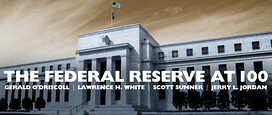In his essay, Jerry Jordan makes a number of important points. I want to bring attention to one insightful if not provocative statement. “At its root, monetary policy is a fiscal instrument in a fiat currency world.” It is a fiscal instrument because it works by varying the rate of inflation, and inflation is a tax. Viewed that way, monetary policy is a separate system of taxation. That was an argument made cogently by Armen A. Alchian and Reuben A. Kessel in a 1962 scholarly article on the “Effects of Inflation.” Given the recent, loose talk about the benficient effects of higher inflation, their argument is worth keeping in mind.
In a gold or other commodity standard world, central banks cannot generate inflation if they want to stay on the standard. The price level is determined globally by the operation of the commodity standard. It might be better to say there is no monetary policy on a commodity standard. Hence, there is no separate fiscal policy run by central banks.
We have low (not no) price inflation, conventionally measured. But conventional measures are misleading. They exclude asset prices, and by that measure, there are quite strong inflationary pressures. Moreover, these pressures are global. The effects of easy Fed monetary policy work there way both directly and indirectly into the asset prices in other countries. Some countries, like Hong Kong, peg their currencies to the U.S. dollar. The exchange rate of the Hong Kong dollar to the U.S. dollar is maintained within a tight band. The Fed’s creation of U.S. dollars directly impacts the supply of Hong Kong dollars. In practice, that first impacts property values and equity prices in Hong Kong.
As John Taylor and others have argued, even central banks that maintain a floating exchange rate against the U.S. dollar cannot realistically fight Fed policy. To do so would cause a crippling appreciation of the exchange rate of the local currency. Hence, the Fed is exporting global asset-price inflation.
In the meantime, the Fed is engaged in what is called financial repression. By keeping nominal interest rates very low, the Fed ensures that real (inflation-adjusted) interest rates are negative. There is a massive transfer from middle-class savers to favored investors and speculators. The benficiaries are wealthier and bceome more so in the process. They are often politically connected. It is a shocking and largely unremarked regressive income-transfer policy. Once again, it illustrates how monetary policy in a fiat currency world is ficsal policy.
In his further contribution to the discussion, Jordan correctly focuses on Fed governance and the scope for massive discetion. As he observes, there are no rules governing the actions of central banks in a fiat currency world. That greatly exaccerbates the problems discussed above.

